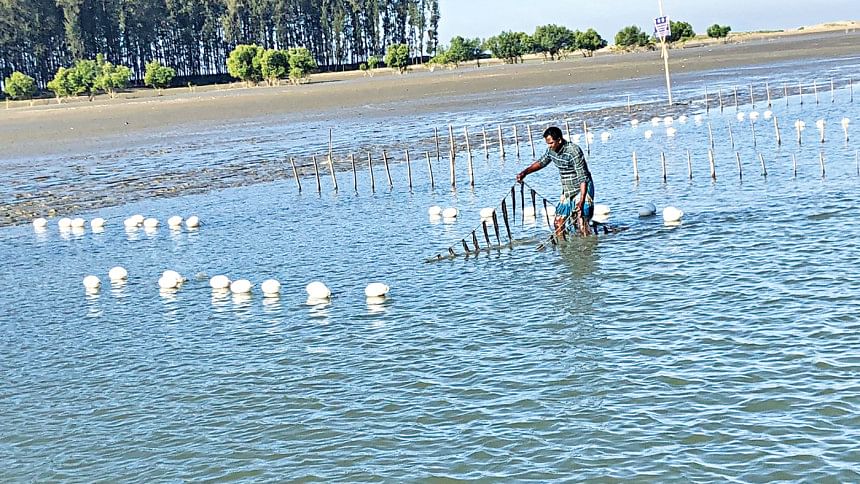Seaweed farming gains traction

If people visit Reju Khal, a hill stream that flows through the southern part of Cox's Bazar district and into the Bay of Bengal, they would see long queues of bamboo poles along the waterway.
The poles are used for an artificial method of growing seaweed that entails knotting two grams of seed into a rope with 20 centimetre intervals. The rope is then tied between the poles and placed in saline water, where the seeds sprout into plants weighing roughly 400-500 grams.
Mohammad Idris, a resident of the area, has been cultivating seaweed in this manner since 2016.
"The process is very easy as seaweed grows fast," Idris told The Daily Star.
Idris works with a team of around two dozen people to earn a monthly income of around Tk 15,000.
"I don't need to regularly tend to the farm and instead go around eight days a month for group cultivation," he said.
Like him, many people in coastal areas have started cultivating seaweed, opening the door to boost Bangladesh's blue economy.
Globally, seaweed farming is one of the fastest-growing aquaculture sectors with an annual production of about 33 billion tonnes valued at $11.8 billion, which is expected to double by 2024.
Full of vitamins, minerals, and fibre, Japanese people have been eating the plant with a mix of other food items, such as rice, for centuries.
Besides, seaweed has good demand among consumers in neighbouring Myanmar as well.
About 32 types of seaweed are abundant along the coast of Bangladesh, where 14 of these species are commercially viable but only four variants are being farmed, that too on a small scale.
With over 700 kilometres of coastline and 25,000 square kilometres of coastal area, Bangladesh has enormous potential for seaweed cultivation as the country's beaches, estuaries and mangroves make it an ideal habitat for the plant, according to the Food and Agriculture Organisation (FAO).
In Bangladesh, approximately 300 households are engaged in seaweed framing at Nuniarchara, Inany Beach and Reju Khal of Cox's Bazar, producing 390 tonnes in 2020 with potential applications in the food, cosmetic, feed and pharmaceuticals sectors.
If the full potential of this crop is realised, the sector could grow exponentially and create one lakh jobs for people living in coastal areas such as Cox's Bazar, Chattogram, Noakhali, Patuakhali, and Satkhira.
Although the popularity of value-added seaweed products and their acceptance is yet to reach adequate levels among mass consumers, indigenous communities of Cox's Bazar and the nearby hill tracts consume seaweed products.
As a part of its efforts to popularise edible seaweed as well as its use in cosmetics, the FAO recently organised a fair to showcase seaweed products made by local farmers and entrepreneurs.
It also distributed 25 carts to seaweed food entrepreneurs in Cox's Bazar.
Kaaywa May Rakhine, a female entrepreneur who received a cart, told The Daily Star that she uses seaweed in different recipes, from fried crabs to Faluda.
Seaweed-based ready-to-eat foods include salads, cookies, chips, burgers, cakes, chanachur, and jelly while ready-to-cook items include soup, noodles, and tea.
The plant is also used as a garnish on puddings, chapattis, and samuchas.
Jahanara Islam, who started working with the plant back in the 1980s and is considered the pioneer of seaweed cultivation in Bangladesh, said she invented around 130 types of different seaweed-based food items and products.
Before seaweed was cultivated, the residents of St Martin's Island would collect decomposed seaweed from the shoreline.
Currently, 390 tonnes of wet seaweed can fetch Tk 23.4 million at Tk 60 per kilogramme (kg) while the price of dried seaweed varies depending on its use, according to the study.
For example, dried seaweed for food and feed formulation sells at Tk 300 per kg while the price is Tk 1,000 per kg for cosmetic and pharmaceutical applications.
However, ensuring quality when drying seaweed and providing vacuum packaging is necessary to secure higher prices.
"Seaweed is a great resource as it can be eaten as well as used in a wide range of items, including medicine, cosmetics, fertilisers, and biofuels," said Robert D Simpson, the FAO's representative in Bangladesh.
"A technical cooperation project of the FAO demonstrated the viability and potential of commercial seaweed cultivation, processing and marketing in the country," he added.
The fast-growing algae utilises energy from sunlight and takes up nutrients and carbon dioxide from seawater. Scientists suggest the plant could also help fight climate change and offset carbon emissions.

 For all latest news, follow The Daily Star's Google News channel.
For all latest news, follow The Daily Star's Google News channel. 




Comments